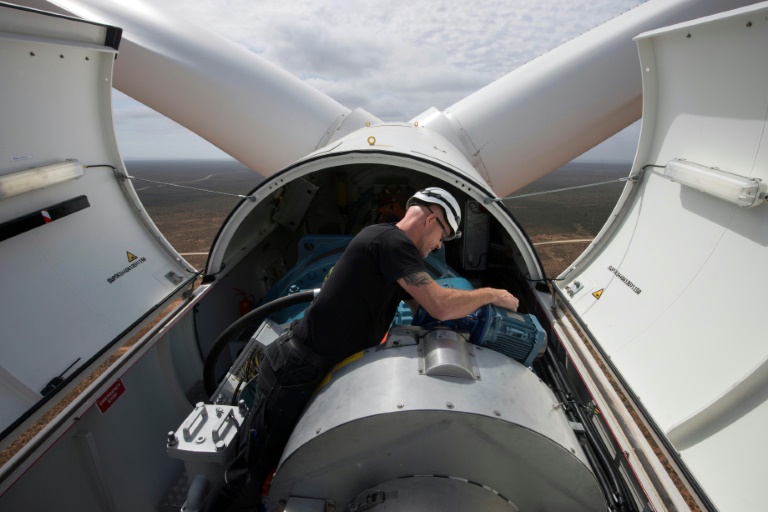Winds of change: How the renewables revolution is harnessing AI

Technical problems with some wind turbines is one reason lenders are reluctant to take on additional risk with Siemens Energy – Copyright AFP SAUL LOEB
The UK government recently announced funding to help deliver clean energy transitions with the expansion of an artificial intelligence (AI) development scheme. Worth up to – and possibly beyond – £100m, renewable energy is set to be the latest industry to benefit from the artificial intelligence revolution.
After many of the nation’s Net Zero commitments were relaxed or reneged on under the Conservative government, increasing the level of automation in the renewables space could be a keyway to reaffirm environmental goals.
To better understand the myriad use cases of AI in the renewables sector, Digital Journal spoke with Charlotte Enright, Head of Renewables at commercial finance experts Anglo Scottish Finance to discuss how AI is being used – and could continue to be used – in the future.
Predicting energy demand peaks and troughs
“If you’re anything like me,” says Enright, “you’ll often pop the kettle on for a cuppa during an ad break when watching terrestrial TV – and even while streaming, thanks to the introduction of ads on popular streaming services.” It’s well-known that this has placed strain on the power grid in the past, but now thanks to AI, we can predict more than just a quick cuppa break.
By analysing vast swathes of power usage data, AI can help the power grid manage demand better by understanding when we’re using energy the most. That same principle applies to renewable energy too: these AI-powered systems can understand when renewable energy is available and when it’s required.
This also makes integrating renewable energy into the grid easier. Predicting wind power can help us to understand how much energy can be collected by turbines, which can in turn forecast how much of it will be available to the grid.
Keeping energy generators up and running
Renewable energy generators, like wind turbines and solar panels, are not immune from wear and tear and the need for maintenance. But rather than waiting for a fault to occur to fix generators, businesses are using AI for predictive maintenance.
This involves using sensors placed on the generators, which will analyse data and predict when it’ll need maintenance performed. “Considering how many of these generators – particularly wind turbines – are placed in remote locations,” Enright comments, “this allows for the strategic scheduling of maintenance to minimise downtime.”
As well as predicting the maintenance of generators like wind turbines, AI can also be harnessed to monitor temperature and identify hot spots on large-scale solar panels, which can indicate malfunctioning cells. Maintenance can be performed on the panels, but in the meantime, they can be re-angled to optimise the power captured.
Simulating and predicting weather conditions
Another of AI’s many renewable applications lies in its ability to predict – and then simulate – future weather conditions.
Enright says: “Renewable energy will always be available in the sense that there will always be sun, wind, organic material and rain. The unpredictability comes in that it’s not always sunny, rainy or windy – and too much or a lack thereof these conditions can then affect organic materials like the growth of grass and plants.”
“Intelligent weather simulators are being used to predict future weather conditions, giving us insight into our future energy capture potential. But these tools are used in a way that far outstrips simple weather reports; one simulator shows how the layout of a city can impact airflow.
“This means that architects can support the future of renewable energy by using this insight to design buildings and cities that work with the weather and renewable energy sources, not against them,” she adds.
Making generators more sustainable
The production of renewable energy supports the fight against climate change, yet it is not necessarily fully sustainable.
Many renewable energy generators are made from rare earth metals, using valuable and limited resources. As well as the materials themselves, the process of manufacturing these generators can be highly energy-intensive.
“AI is being used to speed up trials of new materials and their performance,” Enright adds, “meaning thousands of manual tests can be condensed into a more manageable number. What’s more, AI can support in making sure that these generators are recyclable once they reach their end of life, a key tenet of sustainability.”
The renewable energy sector is one of many that is benefitting from the transformative effects of AI. From ensuring generator uptime is maximised to predicting energy demand and adapting accordingly, this may be one of its most important uses to date.
Winds of change: How the renewables revolution is harnessing AI
#Winds #change #renewables #revolution #harnessing





